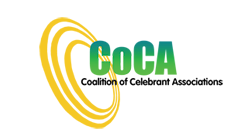The RIS paper purports to describe difficulties with and proposes solutions to the marriage celebrant program but fails in several important areas. Additional, more realistic and possibly more acceptable, less discriminatory, options have not been explored. While the Coalition of Celebrant Associations (CoCA) is opposed to the implementation of an annual registration fee it offers further ‘overlooked’ options towards the end of this paper.
- CoCA is particularly disappointed over the failure of the AGD, MLCS & Finance Department’s to advise, or discuss with CoCA this proposal, prior to release. CoCA believes it is unprecedented for appointees of the AGD to pay anything to a government department beyond taxes.
- Marriage celebrants are compared (in the RIS & on the AGs website) to Migration Agents, who are appointees of the Immigration Department, have to take courses to qualify for appointment, do ongoing Continuing Education and pay a yearly fee to maintain their registration listing.
- However, the Migration Agents’ Registration Authority is a separate self-funded, self-directed distanced part of the Immigration Department, unlike the Marriage Law and Celebrant Section (MLCS) which is a section of the Attorney Generals Department, completely funded out of Commonwealth Consolidated Revenue.
- It is also pointed out a Migration Agent, with whom marriage celebrants have been improperly compared, can receive up to $10,000 or more for an average case within an ongoing case load. Many are specialised lawyers with complex cases involving huge sums of money for business migration, employee migration, family migration, adoption, etc. Most marriage celebrants either barely break even or suffer losses in providing their services to Australia’s marrying public.
Of the 3 classes of persons authorised to conduct marriages, marriage celebrants authorised by the Commonwealth are the only persons for whom an annual registration fee is being considered.
- Ministers of religion (mainstream) and legal officers in States & Territories are exempted from this proposal. This appears contrary to the advice, previously accepted by the AGD from Professor Pryles (http://www.collegeofcelebrancy.com.au/Pages3/Pryles2.html ) that it is discriminatory and unconstitutional to impose such a requirement on persons appointed by the Commonwealth and not upon others such as mainstream religious.
The major element contributing to ensuing difficulties within the marriage celebrant program was permitting appointment of unlimited numbers of marriage celebrants.
- Contrary to advice received from the marriage celebrant industry at the time and was addressed by the Attorney, at the time of introducing the radical changes (referred to as reforms), as noting celebrants’ and celebrant associations’ concern over an anticipated massive increase in numbers – (far outweighing any need for their services) given Australia’s limited and basically static number of marriages each year.
- The Attorney said no substantial increase in numbers was expected given higher training requirements and natural attrition. At that time (pre 2003) couples had no difficulty locating a celebrant to suit them and it was argued there were too many celebrants even then!
- Now, with little change to numbers of marriages in Australia each year, the number of celebrants has grown to in excess of 10,000 and more continue to be appointed. Celebrant numbers prior to 2003 were around 2000 active marriage celebrants Australia wide.
- In keeping with the needs based conditions of the marriage celebrant program no greater number of celebrants was appointed than needed by Australia’s marrying couples.
- The Attorney-General introducing the program, the Hon Lionel Murphy stated ‘there should never be so many celebrants that they cannot acquire the skills and knowledge they and their client couples need’.
- Professionalism of Celebrants. The Ceremonial Role carried out by celebrants is referred to and although improving the professionalism of celebrants is mentioned, nothing in the RIS paper is directed to improving this stated, but seriously overlooked area. The paper is entirely directed towards raising funds for the MLCS to pay staff to ensure statutory compliance. It should be realised simply seeking legal compliance will not, in any way, raise ceremonial or professional standards. There is an initial training requirement and limited annual OPD, but neither is sufficient to ensure high standards of ceremonial performance. Key factors contributing to ceremonial performance is experience, skills and acquired knowledge. These along with effective assessment and selection process are overlooked. The current environment of far too many celebrants for so few weddings limits any improvement.
- The RIS states the legislative regime is robust. However, the truth is existing legislative measures are inadequate. This ranges from inadequate suitability assessment of aspiring celebrants, inadequate & poor quality of training, and little chance to acquire needed experience to lack of genuine performance reviews. An example of the inadequacy of the legislative regime is the approx. 18,000 enquiries received by the MLCS each year from celebrants “who do not fully understand either the legal or administrative requirements of marriage celebrancy and do not comply with their legislative obligations”. The Department comments celebrants are receiving answers to their many enquiries without charge. It is noted, however, the difficulties encountered are not of the celebrant’s making. The Department is entirely responsible for allowing this situation to develop,
- New celebrant training referred to in the RIS document recognises the inadequacy of the Plan Conduct & Review a Marriage Ceremony statement of attainment requirement for appointment from 2003 to 2010. Registered Training Organisations offering new celebrant training has varied from reasonable to appalling and none are under the direct supervision or control of the AGD. The now required Certificate IV in Celebrancy, required since 2010, is being offered by the same RTOs who provided (unsatisfactorily) the Plan Conduct & Review a Marriage Ceremony.
- Ongoing professional development plays an important role in providing celebrants with information on their legislated duties as well as information on their ceremonial skills. However, the Austender process employed to select only three approved OPD service providers without input of any type from experienced marriage celebrants is questionable. Not all approved OPD providers had reached the required state of readiness to provide OPD training when required and some exhibited inadequate knowledge of suitable topics for celebrants. Additionally, there have been anecdotal reports of errors of legal interpretation made by inexperienced trainers.
- An application fee of say $500, together with effective suitability assessment methods and training requirements, would more properly target the needs of the Department and should limit applications to more determined and appropriately motivated persons. At the moment the Department’s Fit & Proper Person Criteria requires information and references provided by the applicant. There is no interview or independent suitability assessment.
- If an annual registration fee is in accordance with law, the constitution and principles permitting the Commonwealth to seek funding to pay public servant salaries, then a modest annual fee of around $100 per Commonwealth appointed marriage celebrants (including independent religious marriage celebrants) and Ministers of Religion for Recognised Denominations could be applied. This removes any accusation or concern over discrimination. Such a ‘listing’ of authorised/registered/listed marriage celebrants would raise around $3.5 million per annum.
- At the same time it should be recognised that escalating costs for the Marriage Legal & Celebrants Section (MLCS) are not the fault of celebrants and celebrants struggling to survive should not be seen as a source for MLCS funding. The principle faults with Australia’s marriage celebrant program are in permitting too many celebrants (resulting in few opportunities for them to acquire and maintain the skills & knowledge they need), inadequate selection processes and poor standards of training.
Tony Gelme
Chair – CoCA. August 2011
You are invited to read our response and make comments if you would like, directly to us via our Contact Us page.


